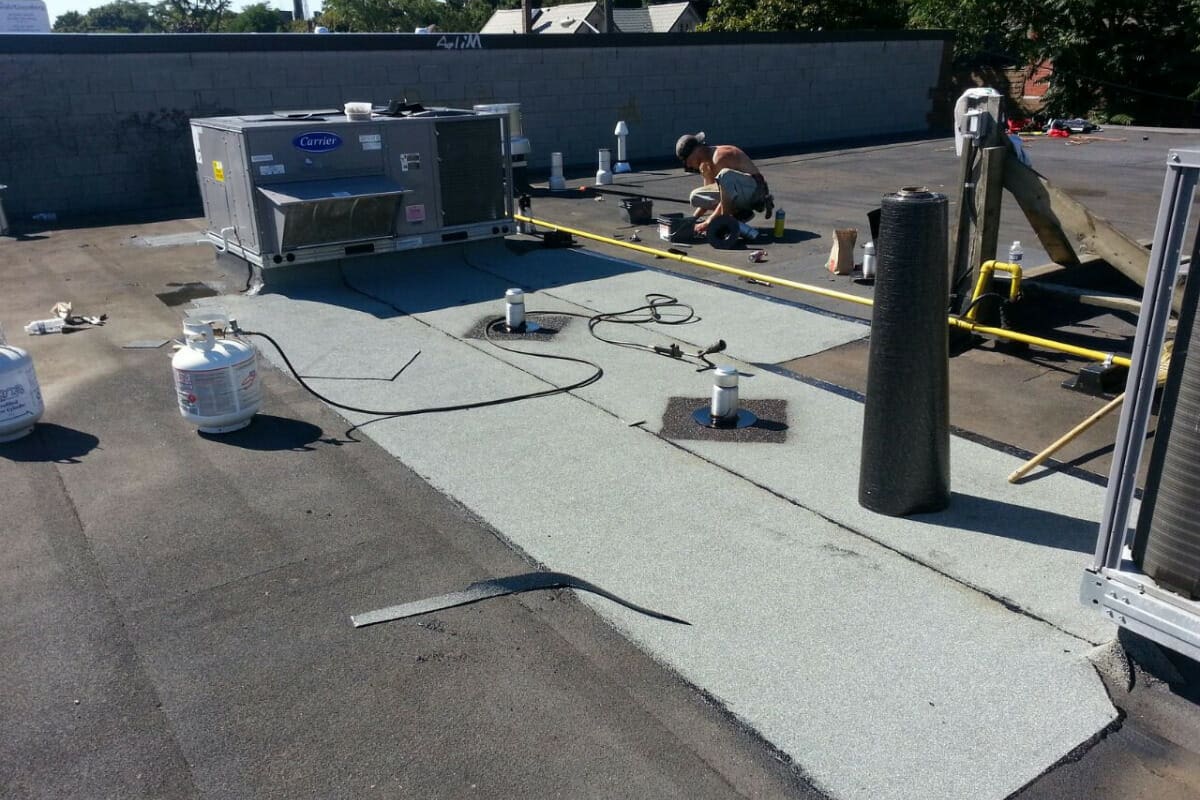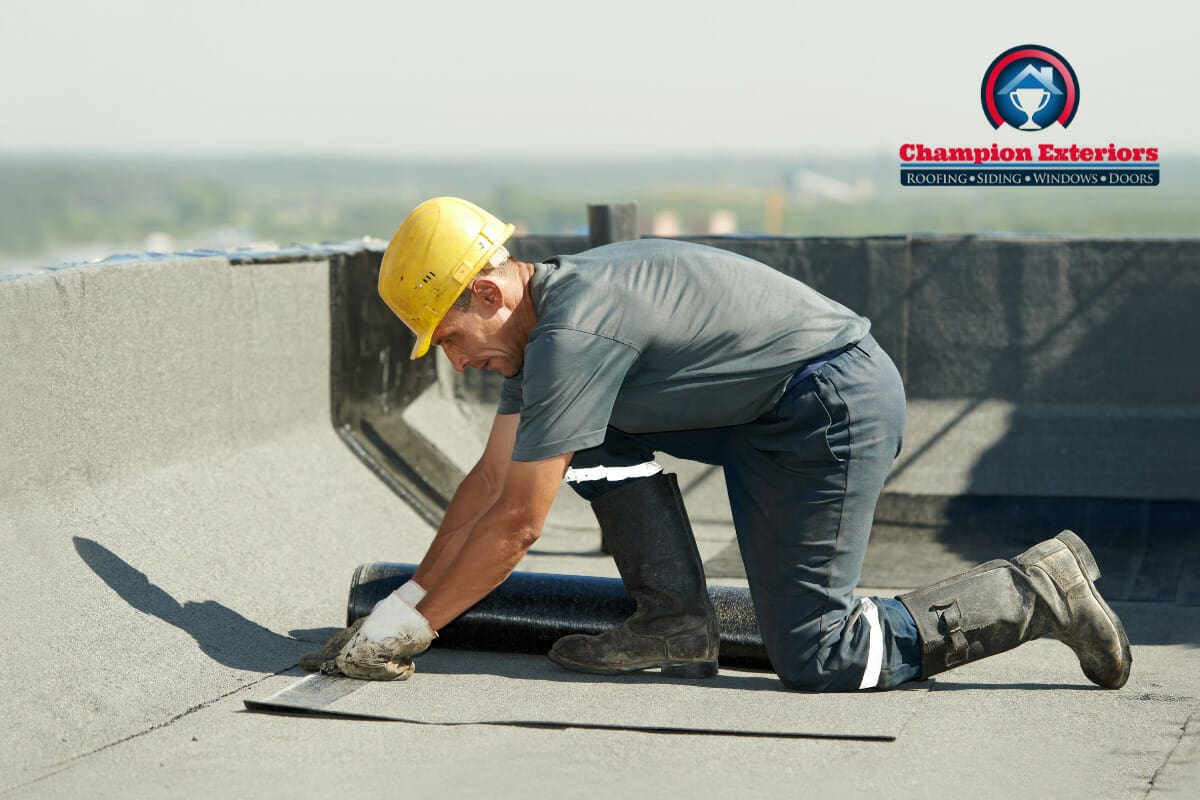Do you have a flat roof that is leaking? It can be overwhelming when your roof starts to leak or gets damaged without warning. Repairing a leaky flat roof can also take time and effort, causing stress for business owners. That’s why they search for simple and fast methods to fix a flat roof leak.
If your roof has recently started leaking or showing signs of damage, it’s best to take action immediately. In this blog post, we have put together some crucial tips and tricks to assist you in dealing with this situation.
Common Causes of Flat Roof Leaks (Or Identifying Leak Cause)
Flat roofs are prone to many problems. We’ve outlined some of the major causes of flat roof damage in the following section that requires repair.
1. Ponding Water: A Call To Action
Ponding water on flat roofs can exacerbate existing leaks and promote the formation of new ones. This is because standing water, particularly if it remains for extended periods, can gradually seep into even minor cracks or imperfections in the roof’s surface, expanding the damage and causing leaks. Furthermore, the weight of accumulated water can put stress on the roofing structure, causing deflection and additional vulnerabilities where water can penetrate. The constant moisture can also degrade roofing materials over time, including the underlying insulation and decking, thereby reducing the roof’s overall lifespan and increasing the risk of leaks. These factors make effective drainage an essential component of flat roof design and maintenance.
2. Poor Installation
Flat roofs require proper installation to function effectively. If the roofing material is not installed with enough slope, or is simply not installed properly, water can accumulate on the roof and lead to leaks. Additionally, if the flashing and sealant used to cover small cracks and gaps in the roof of the building are not properly installed, this can also lead to leaks.
3. Roof Membrane Damage
The membrane that covers a flat roof is one of the most critical components of the roof. It’s responsible for keeping water out of the building. However, this membrane can be damaged by extreme weather conditions, foot traffic, or debris. When the membrane is damaged, it creates a pathway for water to seep into the building and cause leaks.
4. Roof Penetration
Flat roofs often have vents, skylights, or other components that penetrate the surface. These components can be a source of leaks if they are not installed properly or are damaged. For example, if the sealant around a skylight fails, water can seep through the opening and into the building.
5. Lack of Maintenance
Regular maintenance is crucial for any roofing system, and flat roofs are no exception. Without proper maintenance, small problems can become larger and lead to leaks. For example, if the drainage system becomes clogged with debris, water can accumulate on the roof and cause leaks. Similarly, if the roofing material is not inspected regularly, damage may go unnoticed and lead to more serious issues.
Also, read our blog post on how to prevent failure when repairing flat roofs, 7 dos and don’ts of flat roof repair.
Tricks for Quick and Effective Repair
Implementing quick and efficient methods to repair your flat roof can serve as a temporary solution, providing you with more time to arrange for a professional repair or replacement for your roof leak. If you’re pressed for time or too occupied to conduct a thorough repair, the following strategy can offer a possible temporary solution to manage the situation.

Install a Temporary Sealant or Rubber Membrane
After you have identified the source of a leak, you can fix the issue temporarily while you plan for a professional repair. One trick is using temporary sealant to fix small leaks quickly. Or you can install a rubber membrane, which will provide an extra layer of protection against future leaks.
Tools You’ll Need To Fix Your Leaking Flat Roof
Here are some of the required tools you will need to repair a flat roof leak. Use them properly to prevent further damage to the roof.
A Utility Knife
A utility knife is an essential tool for any roofing repair job. It’s primarily used for cutting away damaged sections of roofing material cleanly and precisely, preparing the area for the new patch. High-quality utility knives feature retractable, replaceable blades, which ensure a sharp cutting edge at all times. These blades can cut through various roofing materials including modified bitumen, EPDM, TPO, or PVC membranes, providing the flexibility needed for diverse roofing situations. When using a utility knife, caution is critical to prevent personal injury and to avoid cutting into sound roofing material or the underlying structure.
Roofing Trowel or Spatula
This tool is indispensable for applying and spreading roofing adhesive, cement, or sealant evenly across the damaged area. A roofing trowel or spatula, often made of stainless steel, features a flat blade that can efficiently spread these materials to create a waterproof seal around the repair.
Seam Roller
A seam roller is a critical tool for ensuring the effectiveness of a flat roof repair. After applying the adhesive and laying down the new patch of roofing material, a seam roller is used to press down the material firmly. This tool, typically with a steel or silicone roller, helps to remove any air bubbles and ensure a good bond between the new and existing roofing materials, enhancing the waterproof quality of the repair.
Heat Gun or Torch
In the case of certain types of roofing materials like modified bitumen or some thermoplastics, a heat gun or torch is necessary. The heat source is used to gently warm the existing roofing material and the patch to a temperature that allows them to bond together effectively, forming a seamless, water-resistant barrier. This tool needs to be used with extreme caution, as excessive heat can damage the roofing material or, in worst-case scenarios, cause a fire. It’s also crucial to remember that this tool should be handled only by trained individuals due to the inherent risks involved.
Essential Tips for Flat Roof Leak Repair
Repairing flat roofs requires the following steps we’ve outlined below. Whether you want to repair the roof yourself or hire a professional, you need to understand every step completely.
Locate the Source of the Leak
Finding a leak in a flat roof might initially seem daunting, but it’s not as challenging as you might think. In fact, identifying leaks in flat roofs can often be easier than in sloped roofs due to their design. Typically, signs of leaks may be evident from within the building itself. Look for areas where you can notice water stains, or water dripping. Water stains typically appear on walls adjacent to the source of a leak, providing further clues to pinpoint the exact location of the issue.
Clean the Roof’s Surface
Before you begin the process of repairing or patching your roof, it’s crucial to thoroughly clean the surface of the roof. Any accumulated dirt, grease, or residue can hinder the adhesion of the new material and compromise the seal. To accomplish this, you’ll need to safely access your roof, which is typically done using an extension ladder. Once on the roof, you can use a wire brush to scrub off stubborn dirt or debris. Afterward, use cotton rags to wipe the surface clean, ensuring it’s ready for the repair or patching process.
Seal Small Cracks and Holes
For minor damage, such as small cracks and holes, you can use roofing cement or sealant to fill them in. You can use a utility knife to cut away the damaged area and use a putty knife or a caulk gun to apply a thin layer of roofing cement or sealant over the damaged area.
Apply Roof Patches
For larger areas of damage, such as big tears or punctures, you will need to apply roof patches or replace the damaged area with a new membrane. Use a utility knife to cut away the damaged area and then use roofing adhesive to adhere a new piece of membrane or a patch that matches the type and color of your existing roofing membrane.
Hire a Professional
If the extent of the damage is large enough, or if you’re attempting DIY roof leak repair for the first time, it is best to hire a professional. A professional roofer will analyze the damage properly without harming the roof’s integrity, and be able to provide repairs that are sure to last longer than ones done by inexperienced handymen
Flat Roof Leak Repair Cost
The cost of repairing a flat roof leak isn’t uniform, as it depends on several factors. These include the nature and extent of the damage, the specific location of the damage on the roof, the type of roofing material, the contractor hired, and the labor and time involved in the repair. However, the average flat roof repair cost can range from $300 to $1,100.
Call the Professionals for a Flat Roof Leak Repair
If your flat roof is showing signs of water leaks, delaying the repair process only increases the extent of damage and, therefore, the flat roof repair cost. If you live in New Jersey, call Champion Exteriors today, at (609)-845-3576 for an instant flat or commercial roof repair.


